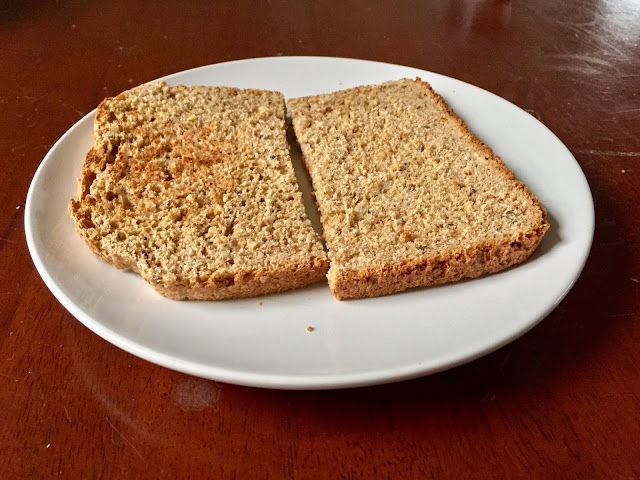- Multigrain cereal, 1 cup
- Boiling water, 1.5 cup
- Vegetable oil, 3 tablespoons
- Honey, 4 tablespoons
- Bread flour, 3 cups
- Salt, 1 teaspoon
- Gluten, 1 tablespoon
- Toasted wheat germ, 2 tablespoons
- Flax seed, 2 tablespoons
- Yeast, 2 teaspoons
The boiling water is intended to soften the multi-grain cereal but must be allowed to cool completely before adding further ingredients. Yeasts do not like extreme temperatures!
I've been making this recipe in my bread machine for about two years and, though it does work, there are some recurring issues: the bread often struggles to rise completely and is very crumbly. The unpredictability of the rise was particularly frustrating and I began experimenting to find a solution. It has taken almost a year and some careful reading of Whole Grain Breads by Peter Reinhart, but I believe I have now found a superior recipe that rises consistently and is marginally less crumbly.
The key modifications are to use cold instead of boiling water, add one egg, and use much more gluten. (I also add a cup of oats and an extra half-cup of water but this is probably not necessary.) There are a few reasons why this gives a better rise. First, using cold tap instead of boiling water does not kill off any natural yeasts in the cereal or other ingredients. The grains will not soften as quickly but I've never noticed a difference in the finished product since the grains soften during baking anyway. Second, adding an egg helps all of the grains stick together by adding protein. The extra gluten is used for the same purpose. Proteins polymerize during kneading to form a cohesive network that traps the gases released by the yeast; if there is not enough protein/gluten in the recipe the gases escape and bread fails to rise. This is, in fact, why there is a distinction between bread flour and other types of flour: Bread flour tends to have a higher percentage of protein that helps the bread rise better. Adding sticky proteins also helps to make the bread less crumbly.
Having enough gluten and other protein in the dough is particularly crucial for multigrain breads because they have so many large, partially-milled grains. Large particles simply do not stick together as readily as small particles. Additionally, the large grains can be very sharp (just examine a flax seed carefully) from the perspective of the polymeric proteins; they act like tiny blades on the polymer chains during kneading, creating holes and allowing precious gas to escape. This is why I have to take care to add extra gluten if I want to substitute some of the bread flour with whole wheat flour.
Another set of parameters to pay attention to during troubleshooting is the amount of water and salt. Yeast needs plenty of water to survive and feed effectively but the dough cannot be too soupy either. Salt generally retards yeast growth and can be added if the bread begins rising too much and then collapsing (alternatively, add less yeast). It is also helpful to use the whole grain setting on the bread machine, as this generally features a longer rise time, but the basic setting often works just as well.
Below is the recipe I am currently using. To get the best results, you will almost certainly need to experiment with the ratio of gluten to grains and the amount of water. Good luck.
- Multigrain cereal, 1 cup
- Oats, 1 cup
- Cold water, 2 cups
- Vegetable oil, 3 tablespoons
- Honey, 4 tablespoons
- Egg, 1 (cracked and shell removed)
- Whole wheat flour, 2 cups
- Bread flour, 1 cup
- Salt, 0.5 teaspoon
- Gluten, 4 tablespoons (at least, add more if using additional whole wheat flour or grains)
- Toasted wheat germ, 3 tablespoons (or as much as desired, but compensate with gluten)
- Flax seed, 2 tablespoons (or as much as desired, but compensate with gluten)
- Yeast, 2 teaspoons

